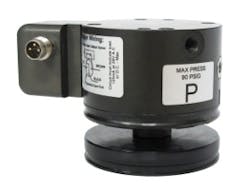ATI Industrial Automation: Robotic Collision Sensor
The unit is designed to absorb the "crash" and reset itself, virtually eliminating tool damage, downtime, and the need for human intervention. It can be used in a variety of applications, including arc welding. Features include high repeatability, large moment and torsional rotation, generous range of motion, an optional spring that provides two trip-points, consistent break-away response, energy absorption, flexible mounting surfaces, automatic reset, rugged design for axial compliance, and adjustable sensitivity. In operation, the collision sensor is adjusted to support typical loads experienced by the robot arm in all directions-angular, compression, and torsional. During the collision, the sensor can comply large distances in response to any type of displacement force. This gives the robot controller ample time to take corrective action. Following the crash, the collision sensor uses precise locating components to reset within 0.001-inch of its original position.
>>For more information on this product, click here
ATI Industrial Automation
www.ati-ia.com
919.772.0115

